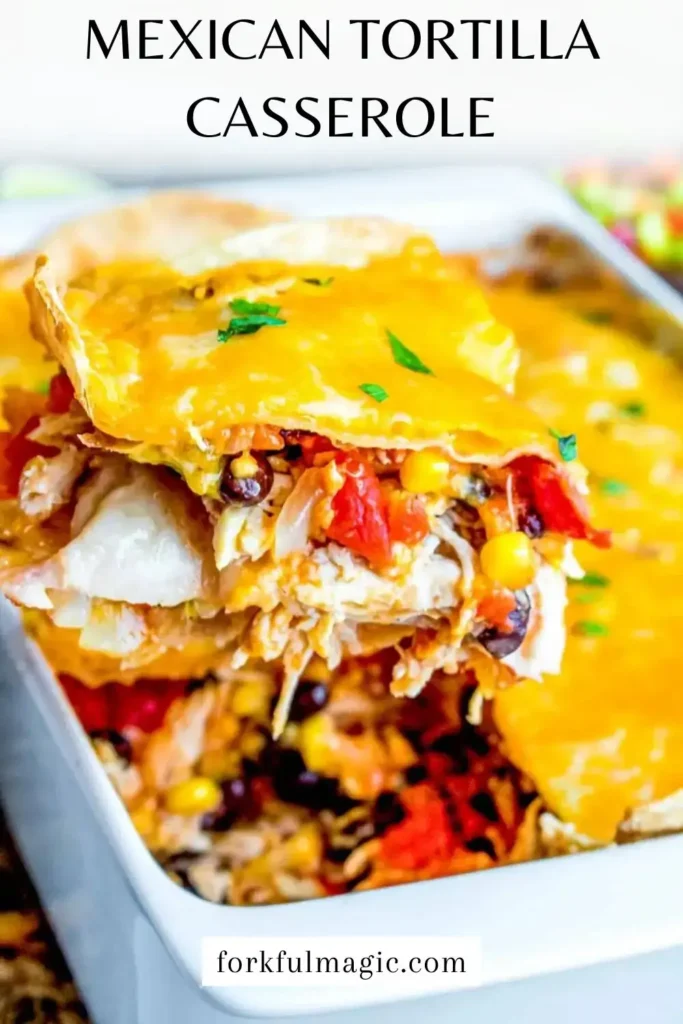Growing up, my abuela would whip up a Mexican tortilla casserole that could make even the most stubborn of food critics swoon. The aroma wafting through the kitchen was a siren call, drawing family and friends alike. This dish, a harmonious blend of flavors and textures, speaks to the heart of Mexican cuisine. Today, let’s dive into the world of tortilla casseroles and discover why this dish is a staple in many households.
What makes a tortilla casserole so special? It’s not just a meal; it’s a canvas for creativity. Layered tortillas, savory fillings, and a melty cheese topping come together in a symphony of tastes. Plus, it’s easy to customize based on dietary needs or personal preferences. Whether you’re a seasoned chef or a beginner, mastering this recipe will surely impress.
Ingredients & Substitutions
Let’s break down the essential ingredients you’ll need for a delicious tortilla casserole:
- Corn tortillas: These provide the base. Opt for fresh if you can. They’re more pliable and have a richer flavor.
- Protein: Ground beef, shredded chicken, or even black beans work wonders. For a vegetarian option, try lentils.
- Cheese: A mix of cheddar and Monterey Jack is ideal. If you’re dairy-free, look for vegan cheese alternatives.
- Vegetables: Onions, bell peppers, and corn add color and flavor. Fresh is always better, but frozen can work in a pinch.
- Tomato sauce: This adds moisture and depth. Use homemade for an upscale touch or canned for convenience.
- Spices: Cumin, chili powder, and garlic powder bring the heat. Fresh herbs, like cilantro, can elevate the dish.
Substitutions: If you’re gluten-sensitive, check if your tortillas are certified gluten-free. For a lower-carb version, cauliflower tortillas are a fantastic option. Don’t forget about fresh vs. dried herbs. Fresh herbs pack a punch, while dried can mellow out flavors. Choose wisely based on your preference.
Step-by-Step Instructions

1. Preheat the Oven
Start by preheating your oven to 350°F (175°C). This ensures even cooking and a bubbly, golden top.
2. Sauté the Vegetables
In a skillet, heat some oil over medium heat. Toss in chopped onions and bell peppers. Sauté until they’re soft. This step builds a flavor base. Don’t rush it. The sweetness from the caramelization is worth the wait.
3. Cook the Protein
Add your chosen protein to the skillet. If using ground beef, break it up as it cooks. You want to achieve a nice browning, which enhances flavor. For beans, heat them through. Season with cumin, chili powder, and a pinch of salt.
4. Assemble the Casserole
In a baking dish, start layering. First, a layer of tortillas, then your protein and veggies, followed by a sprinkle of cheese. Repeat until you’ve used all your ingredients, finishing with a generous cheese layer on top.
5. Bake
Cover your dish with foil and bake for about 25-30 minutes. This keeps moisture in. Then, remove the foil and bake for another 10-15 minutes until the cheese is bubbly and golden.
6. Cool and Serve
Let it cool for a few minutes before slicing. This helps the layers set. Serve it warm, garnished with fresh cilantro or avocado.
Common Mistakes: Avoid overstuffing your layers. Too much filling can lead to a soggy casserole. Also, ensure your tortillas are soft enough to bend without breaking. If they’re stale, consider briefly warming them in the microwave.
Variations
Want to spice things up? Add jalapeños for heat or black olives for a briny punch. Swap out the cheese for a spicy pepper jack. You can even throw in some spinach for added nutrition.
Cooking Techniques & Science

Understanding why certain techniques are used can elevate your dish. Sautéing vegetables first releases their natural sugars, creating a more complex flavor profile. Browning proteins before layering locks in their juices, making every bite succulent.
The science of layering is crucial here. Each layer contributes to the overall texture and flavor. The tortillas absorb moisture, creating a delightful contrast between the crispy edges and soft interior. This interplay of textures is what makes a great casserole.
Important Tools
A good-quality skillet is essential for sautéing. A glass or ceramic baking dish allows you to see the layers as they cook. A sharp knife is crucial for perfect slices when serving.
Serving & Pairing Suggestions
Presentation is key. Serve your casserole in the baking dish for a rustic feel. Garnish with chopped cilantro, sour cream, or avocado slices. This adds freshness and a pop of color.
Pair it with a simple green salad dressed in lime vinaigrette to cut through the richness. For drinks, a light Mexican beer or a refreshing agua fresca complements the flavors beautifully.
Conclusion
Mastering the Mexican tortilla casserole is not just about following a recipe; it’s about embracing creativity in the kitchen. Each layer tells a story, reflecting the rich culinary traditions of Mexico.
Remember to experiment with ingredients and techniques. Whether you lean towards spicy or savory, the options are endless.
Final Expert Tips
Always taste as you go. Adjust seasoning based on your palate. If your casserole seems dry, add a bit more sauce before baking. And don’t shy away from leftovers; they often taste even better the next day!
FAQs
1. Can I make this casserole ahead of time?
Absolutely! Assemble it the night before and bake it just before serving.
2. What’s the best way to store leftovers?
Store in an airtight container in the fridge for up to three days. Reheat in the oven for best results.
3. Can I freeze this casserole?
Yes, it freezes well. Just make sure to cover it tightly. Thaw in the fridge before baking.
4. How do I prevent my casserole from becoming soggy?
Use fresh tortillas and avoid overloading with filling. Layering properly helps too.
5. What if I don’t like certain vegetables?
Feel free to customize with your favorites. Zucchini, mushrooms, or even sweet potatoes can be great additions.
This Mexican tortilla casserole can become a beloved part of your cooking repertoire. Dive in, explore, and enjoy the journey!








